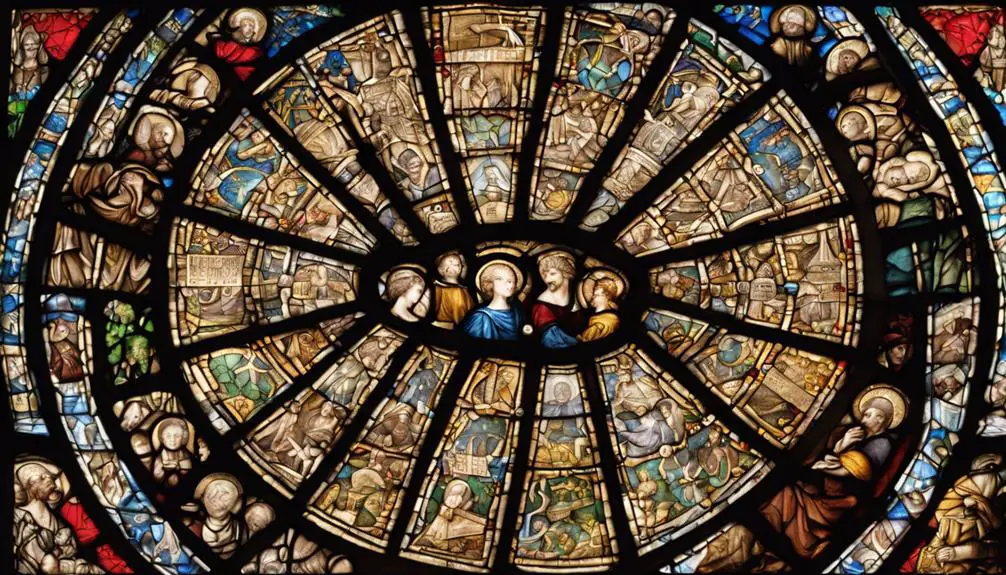Observe the Bible's veiled messages, from prophetic numbers to allegorical interpretations, and let them transform your understanding of faith and spirituality.

Covert Meaning in the Bible
You're embarking on an exploration of the Bible's 'unspoken whispers,' or the covert meanings hidden within its text. These concealed messages, whether they be revelations, prophetic numbers, parables, or allegorical interpretations, are not immediately apparent, and often require deep contemplation and understanding.
How might these hidden codes influence your interpretation of the Holy Scriptures and, ultimately, your faith? Stick around to start a fascinating journey into the Bible's deeper, more mystical layers.
Key Takeaways
- The Bible uses colors, numbers, animals, and natural elements as symbols to convey deeper spiritual truths and concepts.
- Numerology plays a significant role in biblical interpretation, with numbers like 7 and 12 symbolizing completeness and divine authority respectively.
- Prophecies and hidden messages in the Bible provide essential insights into God's overarching plan and the spiritual tapestry of the scripture.
- The understanding of parables, allegories, and divine metaphors enhances comprehension of biblical truths and reveals moral and spiritual lessons.
Deciphering Biblical Symbolism

To truly understand the Bible, you need to decode the numerous symbols that are intricately woven into its passages. One of the notable areas of symbolism is the use of colors. Symbolic colors hold a profound significance in biblical texts. For instance, red often symbolizes warfare or sin, while white tends to represent purity or righteousness. Green, on the other hand, is commonly associated with life, growth, and fertility.
Biblical animals also play pivotal roles in symbolism. Consider the dove, which is frequently used to symbolize the Holy Spirit, peace, or innocence. The lion, recognized as a symbol of strength and royalty, often refers to Jesus Christ in the New Testament. Alternatively, the snake is usually portrayed as an embodiment of evil or deception.
Deciphering these symbols isn't about literal interpretation. It's more about grasping the underlying messages and lessons. Understanding these symbols provides a deeper comprehension of the biblical text and allows you to engage more profoundly with its teachings. So, next time you're reading the Bible, pay close attention to symbolic colors and biblical animals. They're not just words or images; they're keys to unlock a deeper understanding of the scriptures.
Numerology in the Scriptures

Have you ever noticed how certain numbers repeatedly appear in the Bible, hinting at more than just a numerical value? This is a phenomenon known as Divine Mathematics, a system of biblically significant numbers that seem to carry a deeper, spiritual meaning.
Consider, for example, the number 7. It appears over 700 times throughout the scriptures, often signifying completeness or perfection. The creation narrative, the seven trumpets in Revelations, the seven churches – the consistent recurrence of this number can't be a coincidence, can it?
Then there's the number 12, which has its own prominence. The 12 tribes of Israel, the 12 apostles of Jesus, and even the 12 gates of the New Jerusalem. This number often symbolizes God's power and authority.
Within these patterns, some even believe there are Angelic Codes, or divine messages communicated through numerical sequences. But it's important to approach this with caution and an analytical mind. Numerology can offer fascinating insights, but it shouldn't overshadow the core messages of faith, love, and salvation in the scriptures.
Prophecies and Hidden Messages

Delving deeper into the scriptures, you'll find a wealth of prophecies and hidden messages that reveal a profound layer of spiritual meaning. These aren't simply ambiguous predictions; they're intricate prophetic timelines and Messianic predictions, often encoded in layers of symbolism and metaphor.
Examine the prophetic timelines, for instance. They're not just arbitrary dates but meticulously calculated epochs that correspond to specific events. The Book of Daniel, for example, details a timeline predicting the arrival and crucifixion of Jesus Christ with astonishing accuracy.
Now let's consider the Messianic predictions. These prophecies, scattered throughout the Old Testament, foretell the coming of a Messiah, a savior. They're not just vague promises but detailed forecasts, including where he'd be born, how he'd live, and even how he'd die.
These prophecies and hidden messages aren't mere curiosities; they're integral parts of the Bible's spiritual tapestry. They provide a deeper understanding of the scriptures, offering clues to God's overarching plan. So, as you continue your exploration, remember: every prophecy, every hidden message, is a piece of a larger puzzle, a fragment of a grand design.
Metaphorical Interpretations in the Bible

Just as prophecies and hidden messages enrich our understanding of the Bible, so too can metaphorical interpretations provide an added depth to the scriptures. You'll find that Divine Metaphors and Biblical Idioms are integral to this approach.
Divine Metaphors in the Bible aren't just literary devices; they're tools for presenting abstract divine attributes in a way you can understand. For example, God is often referred to as a 'Shepherd'. This metaphor paints a picture of God's guidance, protection, and care — qualities you'd associate with a shepherd.
Biblical Idioms, on the other hand, are phrases with meanings that can't be deduced from the words themselves. For instance, the idiom 'eye for an eye' doesn't literally mean gouging out someone's eye. Instead, it conveys the concept of justice: a wrongdoing should be punished in a manner equivalent to the injury caused.
Understanding these metaphorical interpretations doesn't diminish the Bible's literal truth; it enhances it. By delving into the metaphors and idioms, you're not just reading the Bible — you're exploring it, and in doing so, you're gaining a deeper appreciation for its profound lessons and timeless wisdom.
Unraveling Parables and Allegories

Ever wondered about the mysteries enclosed within the parables and allegories in the Bible? You're not alone. Parable analysis and allegory comprehension are key to unlocking these spiritual enigmas.
Consider the following table:
Parable/Allegory |
Interpretation |
Biblical Reference |
|---|---|---|
The Good Samaritan |
Love your neighbor as yourself |
Luke 10:25-37 |
The Prodigal Son |
God's love is unconditional |
Luke 15:11-32 |
The Mustard Seed |
Faith, even small, can move mountains |
Matthew 13:31-32 |
The Vineyard Workers |
God's grace is equally given, regardless of merit |
Matthew 20:1-16 |
The Wise and Foolish Builders |
True wisdom lies in following God's word |
Matthew 7:24-27 |
Through parable analysis, you can identify the moral or spiritual lesson behind each story. Likewise, allegory comprehension allows you to grasp the symbolic meaning behind biblical narratives.
Frequently Asked Questions
How Has the Translation of the Bible Over Time Affected Its Covert Meanings?
As you analyze the translation accuracy of any text over time, consider language evolution. It's significant how meanings subtly shift, potentially altering the original intention.
With the Bible, translations over centuries could have unintentionally modified its hidden meanings. You're not just translating words, but cultural context and nuanced symbolism, too.
What Role Does Cultural Context Play in Understanding the Bible's Covert Meanings?
Cultural context plays a crucial role in understanding symbolic parables and contextual interpretation of any literature, including religious texts. You must consider the time, place, and culture when these texts were written.
It's not just about translating words, but also understanding metaphors, idioms, and references that mightn't make sense in another culture or era. So, to fully grasp the covert meanings, you must study the culture of that time.
Are There Any Controversial Hidden Meanings That Have Been Discovered in the Bible?
Yes, there are controversial hidden meanings in the Bible, often rooted in Biblical symbolism and nuances of ancient languages. It's crucial to approach these interpretations with an open mind and respectful skepticism.
Analysis of these meanings can lead to heated debates, as they often challenge traditional beliefs. Subtle nuances in translation and cultural context can significantly alter one's understanding.
How Do Different Denominations Interpret Covert Meanings in the Bible?
Different denominations use a range of interpretative techniques to understand the Bible. These denominational differences often result in varied perceptions of hidden meanings.
For some, a literal approach is taken, while others prefer a more symbolic interpretation. It's not just about reading the words, but deciphering the underlying messages.
They may not always agree, but it's this diversity that contributes to the broader understanding of Biblical texts.
How Does Understanding These Covert Meanings Impact One's Faith and Religious Practices?
Understanding symbolic interpretations and parable analysis can deeply impact your faith and religious practices. It provides greater insight into the teachings, allowing you to connect more personally and profoundly.
Recognizing covert meanings can enhance your spiritual growth, making religious practices more meaningful and enriching. It's not just about following rituals, it's about grasping their depth, which in turn strengthens your belief system.
This understanding can transform your religious journey.
Conclusion
You've delved into the covert meanings in the Bible, from symbolic interpretations and numerology to prophecies and allegories.
Remember, the Bible is a multi-layered text, full of hidden messages and metaphors that warrant careful study.
You're now equipped to explore these layers, uncovering the spiritual truths concealed within.
Keep mining its depths, and you'll continually find fresh insights, strengthening your faith and deepening your understanding.



Sign up